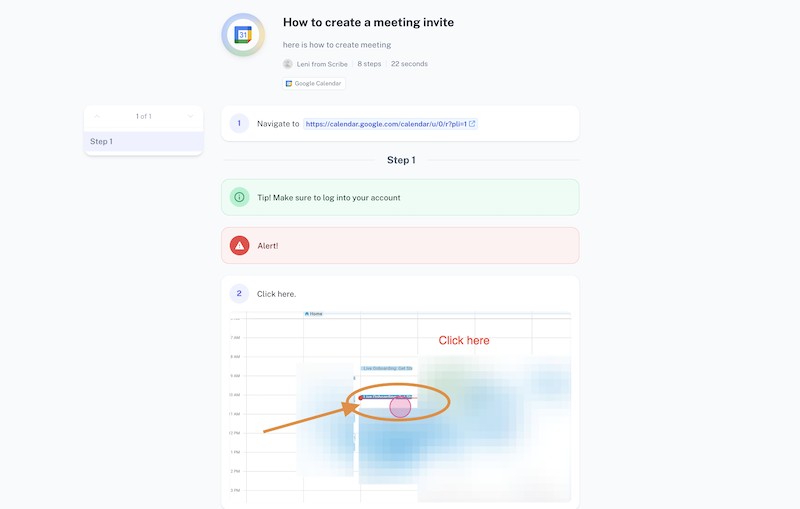Creating a how-to guide is a straightforward process of providing step-by-step instructions, but crafting an effective one requires more than just listing steps. This guide from CONDUCT.EDU.VN offers comprehensive insights into creating impactful how-to guides, complete with examples, templates, and tips to elevate your content. Learn effective methods, practical advice, and discover the art of creating engaging step-by-step procedures and guidelines.
1. Understanding the Essence of a How-To Guide
A how-to guide, sometimes called a “how-to” or “step-by-step guide,” presents a detailed process from beginning to end. Each step is typically accompanied by an image and example to provide context. The content can range from informal tasks to complex step-by-step procedures.
The type of guide you create will depend on the goal behind your content.
Millions of businesses write a guide for different purposes, such as:
- Building work instructions for team members.
- Providing relevant information on a product or service.
- Getting search engine visibility for inbound marketing.
- Sharing user manuals for a better customer experience.
2. Structuring Your How-To Guide
The format of a how-to guide can vary depending on its purpose, but most effective guides follow a similar structure:
- Clear Title: A concise and descriptive title that immediately tells the reader what the guide is about.
- Brief Overview: An introduction that provides context and sets expectations.
- Logical Steps: A well-organized sequence of steps that are easy to follow.
- Visual Aids: Images, videos, or diagrams that clarify each step.
- Desired Outcome: A clear description of the end result the reader should achieve.
- Additional Resources: Tips, troubleshooting advice, or links to further information.
Consider this how-to guide example, which includes:
- A clear title that aligns with the topic.
- A brief description of the guide’s purpose.
- Annotated screenshots for each step to enhance clarity.
3. The Importance of Creating How-To Guides
Creating and sharing effective how-to guides offers several unique benefits.
3.1. Quick Answers to Common Questions
If you’re the go-to person on your team, you likely spend a significant amount of time providing essential information to others. This includes helping them:
- Navigate and utilize tools effectively.
- Execute actionable steps to complete processes.
- Minimize confusion and costly errors.
Creating a how-to guide enables you to provide an informative, relevant answer that can be easily stored and shared repeatedly.
3.2. Streamlining Employee Onboarding and Training
According to the Human Capital Institute (HCI), a major challenge in onboarding is the lack of sufficient resources. The same study indicates that 20% of new employees are likely to leave within the first 45 days of employment.
The cost of losing new hires can range from 90% to 200% of the employee’s salary.
While hands-on training is valuable, building a knowledge base with how-to guides offers several advantages:
- Easy Sharing and Repurposing: Valuable information can be easily shared and repurposed.
- Step-by-Step Guidance: New hires receive clear instructions on how to perform their jobs.
- Knowledge Expansion: Employees expand their knowledge and overall productivity.
- Information Capture: New information is captured to avoid confusion and maintain efficiency.
3.3. Enhancing Customer Satisfaction
Customer support documentation is crucial. According to research, 69% of customers prefer to resolve issues on their own. Developing a help center or FAQ page with helpful guides allows customers to:
- Get started with your product or service.
- Explore features and expand their knowledge.
- Troubleshoot common problems.
- Find answers to frequently asked questions.
This approach can reduce support tickets and transform customers into product advocates.
3.4. Strengthening Content Marketing Strategies
Many people search “How to [fill in the blank]” on Google daily. One of the most common reasons people use search engines is to find step-by-step instructions for completing tasks.
Whether your goal is to:
- Attract client leads through inbound marketing.
- Increase awareness of your product or service.
- Establish yourself as a reputable source.
A well-crafted guide is essential for content marketing. Follow these steps:
- Identify high-demand user questions on online forums.
- Create an editorial calendar for blog posts addressing each need.
- Research the topic thoroughly, consulting expert sources.
- Choose a focus keyword for each article and use internal links to related terms.
- Write clear instructions, including images and examples for each step.
- Optimize each post for search engine visibility to increase traffic.
- Publish your guide, providing valuable content to your target audience.
4. Detailed Steps to Create a How-To Guide
Whether you’re using specialized tools or writing manually, follow these steps to create effective how-to guides:
4.1. Know Your Target Audience
Before writing, understand who you are addressing. The guide should cater to the audience’s knowledge level, language style, and pain points. You can learn about your audience by:
- Analyzing user data and support tickets.
- Participating in online forums.
- Conducting surveys of current users or new readers.
- Reviewing “People Also Ask…” sections on Google.
4.2. Research Your Topic
An effective guide addresses the reader’s needs by solving their problem with up-to-date information, useful images, and authoritative content. If necessary, consult external sources to ensure you have expert opinions.
4.3. Write Your How-To Guide
- Create an Outline: Develop a clear structure with a title, summary, and process steps.
- Add a Summary: Provide a quick overview of the topic and expected result.
- Use Logical Order: Present actionable steps in a clear and concise manner.
- Add Useful Images: Include visual aids like annotated screenshots to enhance clarity.
4.4. Review and Publish Your How-To Guide
- Review the Content: Ensure the guide stays on topic and provides useful information.
- Proofread for Errors: Check for spelling errors, grammar, and inconsistencies.
- Test the Guide: Walk through the steps to ensure the desired result is achieved.
- Publish the Guide: Post it on your blog, knowledge base, or community workspace.
4.5. Distribute Your How-To Guide
Share with Employees: Ensure teammates can access guides through your knowledge base or process documentation tool. Use company emails or community workspaces to spread the word.
Share with Customers: Add your guide to your user help center or FAQ page. Address common queries with practical examples.
Share in Content Marketing: Use keyword-rich headings, body text, and a consistent tone to improve search engine visibility. Link to gated content to encourage sign-ups.
4.6. Incorporate Feedback
A good how-to guide is a living document. Implement a feedback loop to update your content regularly. Software with built-in feedback features allows users to alert you when steps are outdated.
5. Examining Effective How-To Guide Examples
Different types of how-to guides serve different needs. Here are six real-life examples:
5.1. The Standard How-to Guide
A standard guide provides:
- The purpose of the guide.
- Creator information and creation time.
- Number of process steps.
- User reactions.
- Step-by-step instructions with annotated screenshots.
5.2. The Recipe How-to Guide
A recipe guide typically includes:
- Preparation and cooking time.
- List of required ingredients.
- Skill level required.
- Instructions for successful preparation.
5.3. The B2B How-to Guide
A B2B guide provides essential background information, answers frequently asked questions, and offers downloadable resources like PDFs.
5.4. The B2C How-to Guide
A B2C guide uses conversational language, avoids technical terms, and links to other relevant articles to keep readers engaged.
5.5. The Product-related How-to Guide
A product-related guide uses clear, neutral language, avoids passive voice, and offers a simple, straightforward user interface.
5.6. The Lifestyle How-to Guide
A lifestyle guide offers succinct, helpful information, uses a conversational tone, and structures content in numbered lists for easy scanning.
6. Essential Tools: How-to Guide Template and Guide Creator
6.1. How-to Guide Template
A comprehensive template includes:
- Introduction
- Overview
- List of materials
- Troubleshooting
- Conclusion
6.2. How-to Guide Creator
Specialized tools like Scribe can automate the creation of visual how-to guides, generating step-by-step instructions with text, links, and annotated screenshots.
7. Addressing Common Challenges in How-To Guide Creation
7.1. Neglecting to Publish Your Guide
A guide is ineffective if it’s not accessible. Share it with your team, customers, and broader audience through knowledge bases or blogs.
7.2. Not Writing for Your Audience
Provide relevant information and avoid unnecessary details. Tailor the content to answer the specific questions your audience is asking.
7.3. Lacking Expertise in the Task
Ensure you have the necessary expertise to describe the task accurately. If not, defer to experts to maintain the quality of information.
7.4. Over-Reliance on Paid Advertising
Focus on organic traffic through SEO to ensure long-term visibility, rather than relying solely on paid ads.
7.5. Insufficient Use of Visuals
Break up text with screenshots, tables, infographics, images, videos, and bullet points to enhance engagement and comprehension.
8. FAQ: Mastering the Art of How-To Guides
Q1: What is the primary goal of a how-to guide?
The primary goal is to provide clear, step-by-step instructions that enable readers to successfully complete a specific task or process.
Q2: Who is the ideal audience for a how-to guide?
The ideal audience is anyone who needs guidance on a particular subject, ranging from beginners to experts looking to refine their skills.
Q3: How do visuals enhance a how-to guide?
Visuals such as images, screenshots, and videos provide clarity, break up text, and help readers better understand each step of the process.
Q4: What are the key elements of a successful how-to guide?
Key elements include a clear title, concise instructions, relevant visuals, a logical structure, and up-to-date information.
Q5: Why is it important to tailor the language to the target audience?
Tailoring the language ensures that the guide is accessible and understandable to the intended audience, avoiding jargon or overly technical terms.
Q6: How can I ensure my how-to guide remains relevant and accurate?
Regularly update your guide with new information, incorporate feedback from users, and verify that all steps are still current and effective.
Q7: What role does SEO play in a how-to guide?
SEO helps increase the visibility of your guide in search engine results, making it easier for people to find and use your instructions.
Q8: How can I measure the effectiveness of my how-to guide?
Effectiveness can be measured through metrics like page views, time spent on page, user feedback, and the number of successful task completions.
Q9: What are some common mistakes to avoid when creating a how-to guide?
Common mistakes include providing unclear instructions, neglecting visuals, failing to test the guide, and not keeping the content up to date.
Q10: How does CONDUCT.EDU.VN help in creating effective how-to guides?
CONDUCT.EDU.VN provides comprehensive information, expert tips, templates, and tools to help users create engaging and practical how-to guides that meet their audience’s needs.
9. Conclusion: Start Creating Impactful How-To Guides
How-to guides are a valuable tool for offering solutions, establishing authority, and achieving tangible results. Now that you know how to create a how-to guide, it’s time to start. Identify your audience, choose your tool, and begin building.
If you’re facing challenges in finding reliable guidelines or need assistance in creating ethical standards for your organization, CONDUCT.EDU.VN is here to help. We provide comprehensive information and practical guidance on various codes of conduct and ethical standards.
For more detailed information and resources, visit CONDUCT.EDU.VN or contact us at 100 Ethics Plaza, Guideline City, CA 90210, United States. You can also reach us via Whatsapp at +1 (707) 555-1234. Let conduct.edu.vn be your partner in promoting ethical behavior and responsible conduct.

